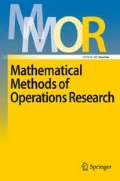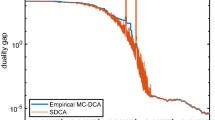Abstract
Blockwise coordinate descent methods have a long tradition in continuous optimization and are also frequently used in discrete optimization under various names. New interest in blockwise coordinate descent methods arises for improving sequential solutions for problems which consist of several planning stages. In this paper we systematically formulate and analyze the blockwise coordinate descent method for integer programming problems. We discuss convergence of the method and properties of the resulting solutions. We extend the notion of Pareto optimality for blockwise coordinate descent to the case that the blocks do not form a partition and compare Pareto optimal solutions to blockwise optimal and to global optimal solutions. Among others we derive a condition which ensures that the solution obtained by blockwise coordinate descent is weakly Pareto optimal and we confirm convergence of the blockwise coordinate descent to a global optimum in matroid polytopes. The results are interpreted in the context of multi-stage linear integer programming problems and illustrated for integrated planning in public transportation.





Similar content being viewed by others
References
Amberg B, Amberg B, Kliewer N (2018) Robust efficiency in urban public transportation: minimizing delay propagation in cost-efficient bus and driver schedules. Transp Sci (published online)
Bilgen B (2007) An iterative fixing variable heuristic for solving a combined blending and distribution planning problem. Springer, Berlin, pp 231–238
Burggraeve S, Bull SH, Lusby RM, Vansteenwegen P (2017) Integrating robust timetabling in line plan optimization for railway systems. Transp Res C 77:134–160
Cadarso L, Marin A (2012) Integration of timetable planning and rolling stock in rapid transit networks. Ann Oper Res 199:113–135
Cooper L (1964) Heuristic methods for location–allocation problems. SIAM Rev 6:37–53
Dasgupta S, Papadimitriou C, Vazirani U (2008) Algorithms. McGraw-Hill, New York
D’Esopo DA (1959) A convex programming procedure. Nav Res Logist Q 6(1):33–42
Drezner Z, Salhi S (2017) Incorporating neighborhood reduction for the solution of the planar p-median problem. Ann Oper Res 258(2):639–654
Drezner Z, Brimberg J, Mladenovićc N, Salhi S (2015) New heuristic algorithms for solving the planar p-median problem. Comput Oper Res 62:296–304
Du Q, Emelianenko M, Ju L (2006) Convergence of the Lloyd algorithm for computing centroidal Voronoi tessellations. SIAM J Numer Anal 44:102–119
Fonseca JP, van der Hurk E, Roberti R, Larsen A (2018) A matheuristic for transfer synchronization through integrated timetabling and vehicle scheduling. Transp Res Part B Methodol 109:128–149
Gattermann P, Schiewe A, Schöbel A (2016) An iterative approach for integrated planning in public transportation. In: 9th triennial symposium on transportation analysis
Gintner V, Steinzen I, Suhl L (2005) A variable fixing heuristic for the multiple-depot integrated vehicle and crew scheduling problem. In: Proceedings of 10th meeting of advanced OR and AI methods in transportation, and 16th mini EURO conference of the EURO working group on transportation (EWGT), pp 547–552
Grippo L, Sciandrone M (2000) On the convergence of the block nonlinear Gauss–Seidel method under convex constraints. Oper Res Lett 26(3):127–136
Guihaire V, Hao J-T (2008) Transit network design and scheduling: a global review. Transp Res Part E 42:1251
Hawkins DM (1994) The feasible solution algorithm for least trimmed squares regression. Comput Stat Data Anal 17(2):185–196
Hildreth C (1957) A quadratic programming procedure. Nav Res Logist Q 4(1):79–85
Jäger S (2016) Iterative algorithms for integrated optimization problems. Masterarbeit, Georg-August-Universität Göttingen, 5
Klamroth K, Mostaghim S, Naujoks BB et al (2017) Multiobjective optimization for interwoven systems. Multi-Critieria Decis Anal 24:71–81
Kleinberg J, Tardos E (2014) Algorithm design: pearson new, International edn. Pearson, London
Liebchen C, Möhring R (2007) The modeling power of the periodic event scheduling problem: railway timetables and beyond. In: Algorithmic methods for railway optimization, volume 4359 of lecture notes in computer science. Springer, pp 3–40
Lloyd SP (1982) Least squares quantization in PCM. IEEE Trans Inf Theory 28(2):129–137
Meng L, Corman F, Zhou X, Tang T (2018) Special issue on integrated optimization models and algorithms in rail planning and control (editorial). Transp Res C 88:87–90
Monderer D, Shapley LS (1996) Potential games. Games Econ Behav 14(1):124–143
Nemhauser GL, Wolsey LA (1988) Integer and combinatorial optimization. Wiley, New York
Pätzold J, Schiewe A, Schiewe P, Schöbel A (2017) Look-ahead approaches for integrated planning in public transportation. In: D’Angelo G, Dollevoet T (eds) 17th workshop on algorithmic approaches for transportation modelling. Optimization, and systems (ATMOS 2017), volume 59 of OpenAccess Series in Informatics (OASIcs). Schloss Dagstuhl-Leibniz-Zentrum fuer Informatik, Dagstuhl, Germany, pp 1–16
Petersen HL, Larsen A, Madsen OBG, Petersen B, Ropke S (2013) The simultaneous vehicle scheduling and passenger service problem. Transp Sci 47(4):603–616
Rousseeuw PJ (1987) Robust regression and outlier detection. Wiley, New York
Schiewe A, Schiewe P (2018) An iterative approach for integrated planning in public transportation. submitted
Schiewe P, Schöbel A (2019) Integrated optimization of sequential planning processes. Working paper
Schmid V, Ehmke JF (2016) Integrated timetabling and vehicle scheduling with balanced departure times. OR Spectr 37(4):903–928
Schmidt M, Schöbel A (2015) Timetabling with passenger routing. OR Spectr 37:75–97
Schöbel A (2017) An eigenmodel for iterative line planning, timetabling and vehicle scheduling in public transportation. Transp Res C 74:348–365
Spühler F (2018) Blockkoordinaten-Abstiegsverfahren für kombinatorische Probleme. Georg-August Univesität Göttingen, Bachelor-Arbeit
Steinzen I, Gintner V, Suhl L, Kliewer N (2010) A time-space network approach for the integrated vehicle- and crew-scheduling problem with multiple depots. Transp Sci 44(3):367–382
Tseng P (2001) Convergence of a block coordinate descent method for nondifferentiable minimization. J Optim Theory Appl 109(3):475–494
Tyrrell Rockafellar R (1970) Convex analysis. Princeton Landmarks in Mathematics and Physics. Princeton University Press, Princeton
Voorneveld M (2000) Best-response potential games. Econ Lett 66(3):289–295
Warga J (1963) Minimizing certain convex functions. J Soc Ind Appl Math 11(3):588–593
Zangwill Willard I (1969) Nonlinear programming: a unified approach. Prentice-Hall International Series in Management. Prentice-Hall, Englewood Cliffs
Author information
Authors and Affiliations
Corresponding author
Additional information
Publisher's Note
Springer Nature remains neutral with regard to jurisdictional claims in published maps and institutional affiliations.
Rights and permissions
About this article
Cite this article
Jäger, S., Schöbel, A. The blockwise coordinate descent method for integer programs. Math Meth Oper Res 91, 357–381 (2020). https://doi.org/10.1007/s00186-019-00673-x
Received:
Revised:
Published:
Issue Date:
DOI: https://doi.org/10.1007/s00186-019-00673-x




